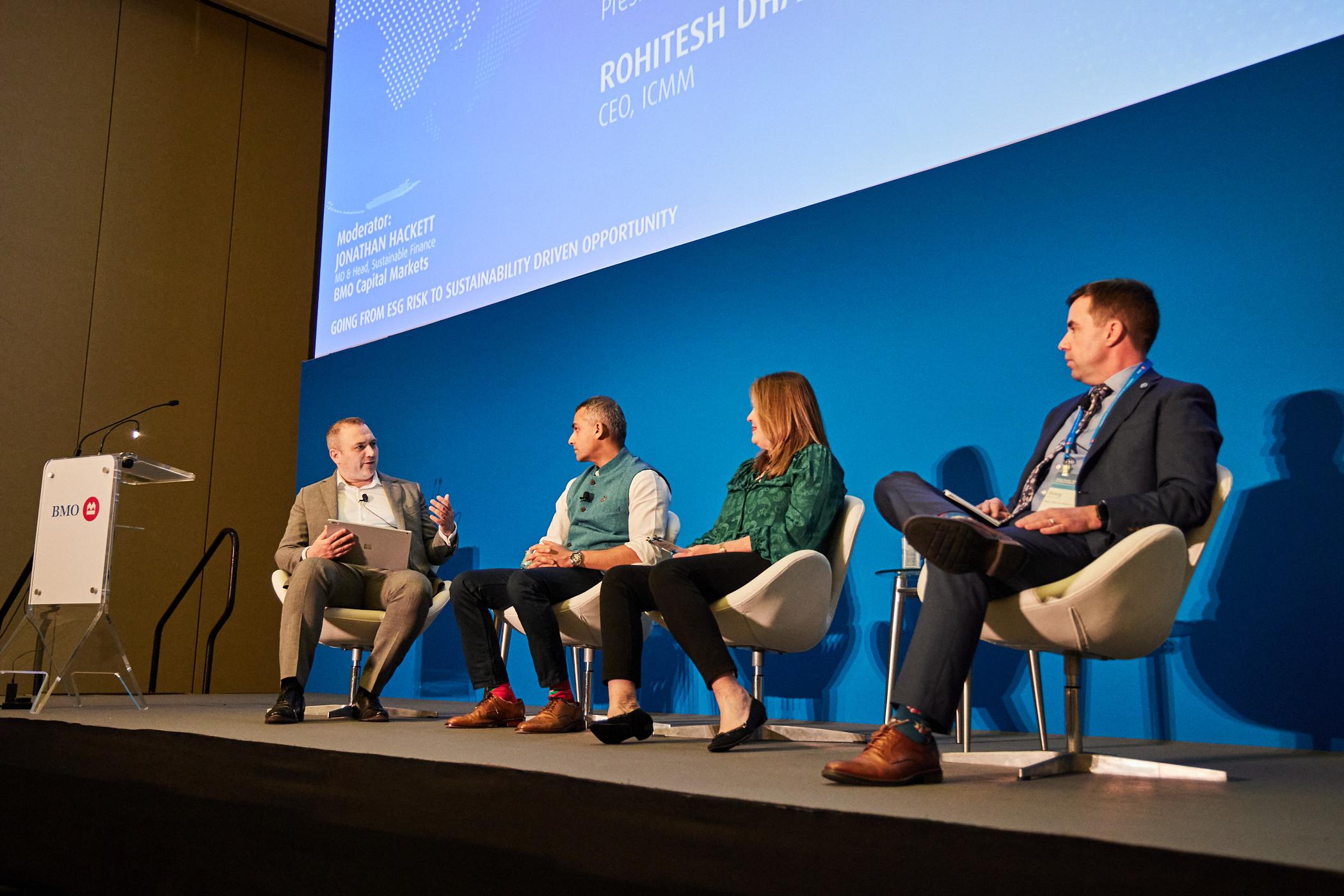Nowhere is the growth in environmental, social and governance (ESG) reporting more evident than it is in the mining sector. Still, according to metals and mining producers who discussed how they are building out their ESG strategies at BMO’s 32nd Global Metals, Mining & Critical Minerals Conference, a continued lack of alignment around consistent, industry-relevant standards remains a concern.
An expert panel devoted to the subject, Going from ESG Risk to Sustainability Driven Opportunity, led by Jonathan Hackett, Co-Head of the BMO Capital Markets Energy Transition Group, delved deep into the subject, exploring the challenges companies face when it comes to ESG. The panel featured Rohitesh Dhawan, CEO of the International Council on Mining & Metals (ICMM), Doug Morrow, ESG Strategist with BMO Capital Markets, and Kathleen Quirk, President and Director of Freeport-McMoRan, and showed broad consensus that the transparency ESG requires of mining companies is a positive development for the industry and is even foundational to a sustainable business model.
“We need to make sure we keep our people and assets safe,” noted Freeport’s Quirk. “We need to foster great relationships with communities over a long period of time, partner with our communities to become more resilient and we need to manage the environmental aspects of our business, because we do have impacts on the environment.” That kind of care and responsibility is at the heart of the ESG movement, added Dhawan.
Increasing Transparency and Opportunity
From an investment perspective, metrics such as greenhouse gas emission intensity, energy used per ton of products or employee fatality rates are generally trending in the right direction, said Morrow, which he believes is because of the ESG push.
“I always go back to the expression that sunshine is the best disinfectant,” said Morrow. “I believe that the push for transparency across the industry should be viewed as an opportunity for mining companies and their investors.”
Quirk explained the importance of company transparency in building trust – not just with investors, but within the communities where their mines exist. Honest and transparent reporting invites more people to ask questions and to challenge the industry to innovate and be held accountable. “It allows us to ask more questions of ourselves,” she said. “And if we’re not transparent, I think that trust breaks down. That’s where you lose your social license if you don’t have mutual trust.”
Consistent Frameworks: What ‘Good’ Looks Like
While ESG reporting transparency is a positive step for the industry, the lack of a consistent reporting framework has led to an abundance of reporting standards. That’s led to a certain amount of reporting fatigue and confusion from issuers and investors about which standards to trust. Consolidation of many of these standards across industries is expected to come in June, noted Morrow, which could help the industry streamline its reporting.
A key issue that must be overcome is how ESG metrics are utilized, said Hackett, who raised the question of whether companies are being rewarded for outcomes, such as fewer workplace injuries, or for their actual ESG practices. The fact is, no matter how ethical a company’s practices are, accidents happen.
“The way we’ve traditionally thought of ESG metrics helps people understand what bad looks like, but it doesn’t help people understand what good looks like,” explained Dhawan. “We’ve got to find a way to fix that.”
It’s increasingly important to show investors and the public at large the positive elements that responsible mining companies bring to the communities they work in. Dhawan shared the story of one mining company that recently committed to becoming nature positive by 2030 by conserving or rehabilitating three hectares of land for every hectare they disturb.
Boosting Value
One question that continues to be asked is whether embracing ESG can result in higher valuations for a company. Dhawan pointed to an aluminum company that has increased profits by marketing its products as containing at least 75% recycled aluminum scrap. It turns out European car manufacturers were willing to pay a premium for their products.
“If you position your business model to lean into the trend towards the circular economy, you can capture that value,” he noted, adding that instances like these are only going to increase over time.
While it’s still early days for assigning a premium valuation to green metals across the board, according to Morrow, “the more substantive policy sticks that are put forward into the market, the greater those rewards and premiums will be,” which will, in turn, incentivize further action.
Still, Morrow cautioned against viewing ESG initiatives through the narrow prism of return on investment. “It’s kind of like poetry: the benefits of ESG are hard to define, but you know it when you see it. If that’s taken away, there would be a deleterious effect on how companies compete and ultimately drive profitability,” he said.
Ticking Boxes
While the proliferation of [inconsistent] ESG ratings can be a source of frustration for investors, they’ve remained the status quo because they’re easy to digest and understand. Morrow believes that’s changing soon, however.
“I think the ESG ratings were an interim step in the evolution of ESG to get things off the ground, but the future is going to hinge much more substantively on industry-relevant performance indicators.”
Ultimately, there is hope and excitement for the future as ESG shifts from being an exercise in checking boxes to a more purposeful, wider-reaching endeavour.
“We are in an incredible, really transformative time for the industry,” noted Quirk. “The decarbonization that’s taking place globally is extremely metals intensive. It’s going to require all of us to do things more innovatively and efficiently. The transparency and accountability that comes from ESG reporting will help us in this regard, not only in being more sustainable from an operating standpoint, but it will also support our ability to attract the new talent and perspectives that will be critical to ensuring the long-term sustainability of our industry.”
